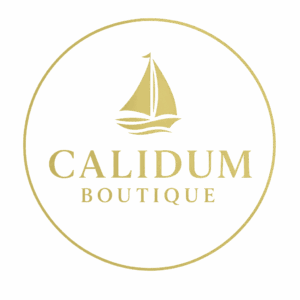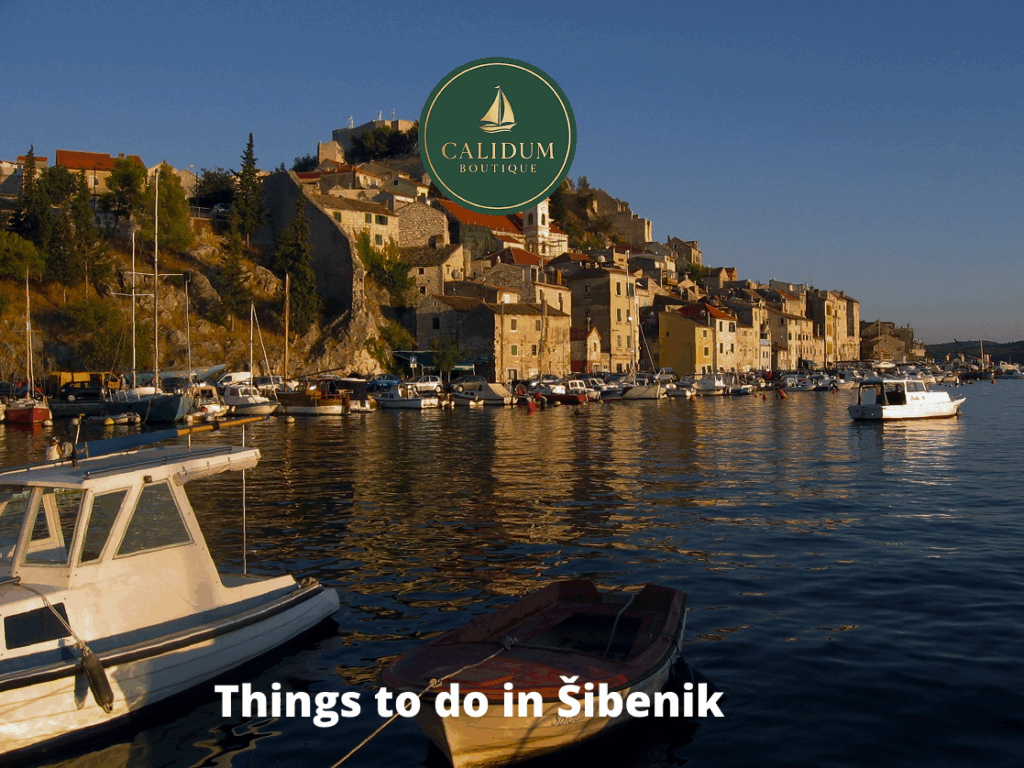
Šibenik is a historic coastal city in Croatia known for its medieval architecture and Adriatic charm. The city combines cultural landmarks with natural attractions, making it one of the most distinctive destinations in Dalmatia. Each site contributes to Šibenik’s identity through architecture, heritage, and scenic views that connect history with the sea.
- Visit St. James Cathedral
- Explore St. Michael’s Fortress
- Walk through the Old Town
- Relax at Banj Beach
- Visit Barone Fortress
- Take a boat trip to Krka National Park
- Explore St. Nicholas Fortress
- Visit the Šibenik City Museum
- Stroll along the waterfront promenade
- Enjoy local seafood at a seaside restaurant
- What are the best cultural experiences in Šibenik?
- What can I do in Šibenik in one day?
- Gdje odsjesti u starom gradu Šibeniku?
Here are things you can do in Šibenik:
- Visit St. James Cathedral — St. James Cathedral is a UNESCO World Heritage Site built entirely of stone in the 15th century. The cathedral combines Gothic and Renaissance styles, displaying detailed sculptures of 71 human heads that represent local citizens.
- Explore St. Michael’s Fortress — St. Michael’s Fortress offers panoramic views over Šibenik and the Adriatic Sea. The fortress dates to the early Middle Ages and today hosts concerts and cultural events during summer evenings.
- Walk through the Old Town — The Old Town consists of narrow stone streets, historic houses, and traditional squares such as Poljana Square. Streets like Kralja Tomislava connect many of the city’s monuments and cafés.
- Relax at Banj Beach — Banj Beach is a pebble beach near the city center with a view of the cathedral and fortress. It features a promenade, bars, and sports courts suitable for families and travelers.
- Visit Barone Fortress — Barone Fortress provides interactive exhibits about Šibenik’s defense system during the 17th century. It is part of the city’s revitalized fortification network and includes a café terrace overlooking the coast.
- Take a boat trip to Krka National Park — Krka National Park is located about 15 kilometers from Šibenik. The park is known for the Skradinski Buk waterfalls and river ecosystem, where visitors can take guided tours or boat excursions.
- Explore St. Nicholas Fortress — St. Nicholas Fortress stands at the entrance to the Šibenik Channel. It was built by the Venetians in the 16th century to protect the city from sea attacks and is recognized as a UNESCO World Heritage Site.
- Visit the Šibenik City Museum — The Šibenik City Museum is located in the former Prince’s Palace and contains archaeological, ethnographic, and historical collections documenting local life from prehistory to modern times.
- Stroll along the waterfront promenade — The waterfront promenade connects the old port with the modern marina. It offers views of nearby islands such as Zlarin and Prvić and is popular for evening walks.
- Enjoy local seafood at a seaside restaurant — Restaurants along the Riva serve traditional Dalmatian dishes such as grilled fish, octopus salad, and black risotto. Examples include restaurants Pelegrini and Bronzin, both known for authentic Adriatic cuisine.
Visit St. James Cathedral
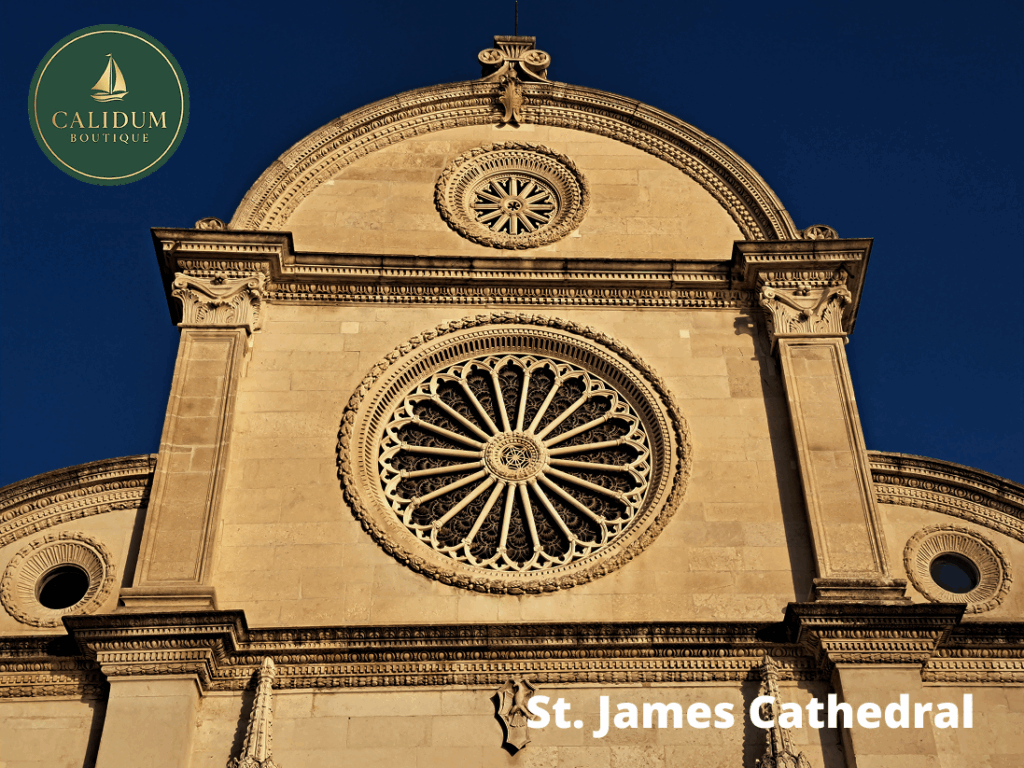
St. James Cathedral is the most famous monument in Šibenik. It is a 15th-century Renaissance and Gothic cathedral built entirely from stone without wood or mortar. The cathedral stands on Trg Republike Hrvatske near the waterfront, and it is a UNESCO World Heritage Site recognized for its architectural innovation and sculptural details.
The cathedral was constructed between 1431 and 1536 by several architects, including Juraj Dalmatinac and Nikola Firentinac. Juraj Dalmatinac designed the structure using interlocking stone slabs, a technique that defines the cathedral’s identity. The dome and baptistery exhibit refined stone carving with human faces representing citizens of Šibenik, nobles, and ordinary townspeople. These sculptural heads are visible on the exterior frieze surrounding the apse, providing a historical record of the city’s people.
Visiting St. James Cathedral is one of the top things to do in Šibenik. The cathedral connects historical, architectural, and spiritual experiences in one place. Visitors can enter the interior to see the vaulted ceilings, detailed altars, and artworks depicting Christian motifs. Nearby attractions include the Šibenik City Museum, St. Michael’s Fortress, and the seafront promenade. Tourists often attend cultural events in the square around the cathedral during summer months. The site is accessible year-round and included in most guided tours of Šibenik.
Explore St. Michael’s Fortress
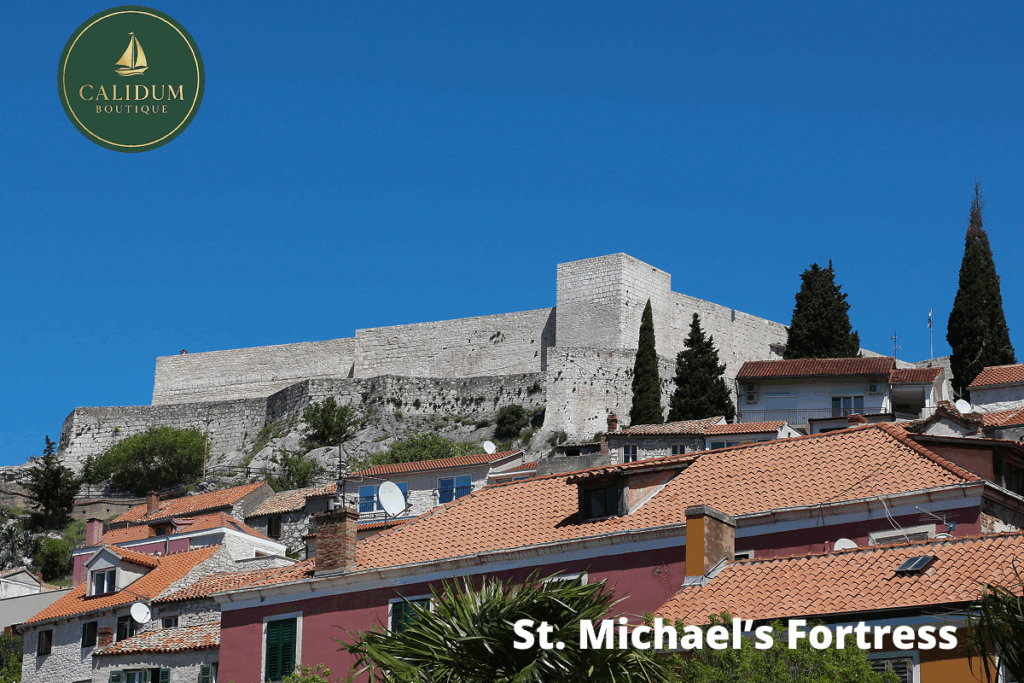
St. Michael’s Fortress is a medieval fortification located above the old town of Šibenik. It is one of the most significant historical sites in Dalmatia and serves as a cultural and concert venue offering panoramic views of the Adriatic Sea and the Šibenik Channel.
St. Michael’s Fortress stands at an elevation of about 60 meters above sea level and dates back to the early Middle Ages. The fortress was named after St. Michael, the patron saint of Šibenik, and historically protected the city from sea invasions. Its stone walls and defensive towers reflect 13th–16th-century military architecture. The fortress does preservation through reconstruction projects supported by the European Regional Development Fund.
Visiting St. Michael’s Fortress is among the most popular activities in Šibenik. The St. Michael’s Fortress includes an open-air stage with a capacity of over 1000 seats, hosting concerts by artists such as 2Cellos and The National. Tourists can explore exhibitions showing medieval artifacts, city defense history, and architectural restoration models. Other nearby attractions include Barone Fortress, St. Nicholas Fortress, and St. James Cathedral, examples of UNESCO-protected heritage.
Walk through the Old Town
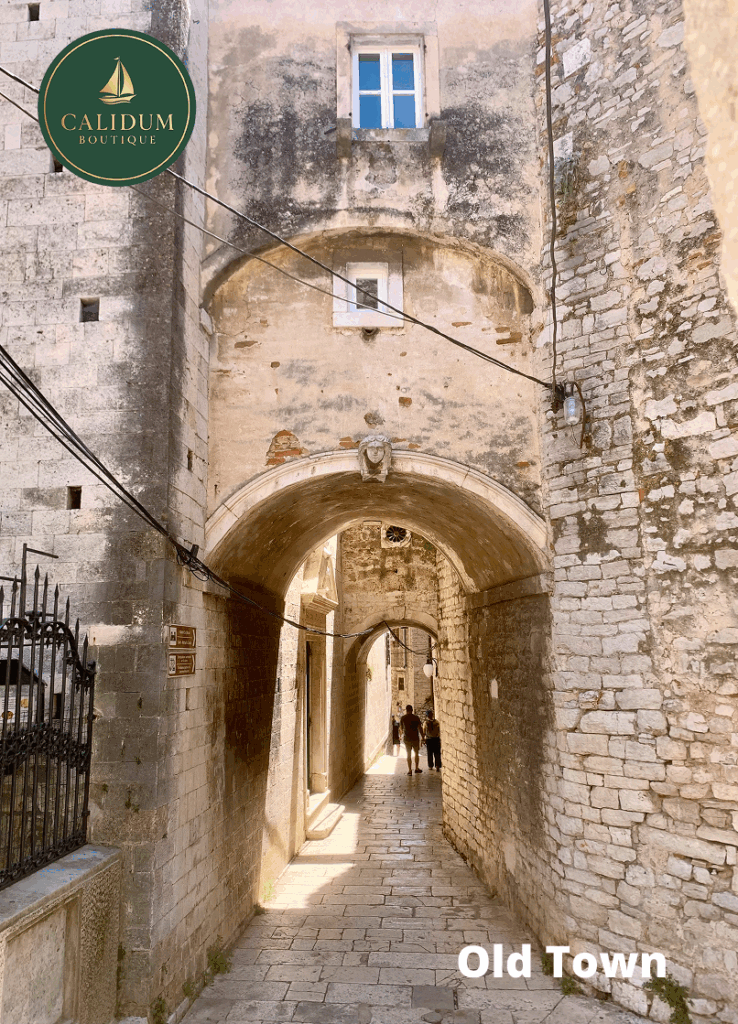
Walking through the Old Town of Šibenik is a historical experience that connects medieval architecture with modern coastal life. The Old Town forms the core of Šibenik’s identity through its narrow stone streets, Venetian buildings, and cultural landmarks. The area includes notable sites such as St. James Cathedral, St. Michael’s Fortress, and Republic Square, each representing key periods of Dalmatian history.
The Old Town streets are paved with polished limestone that reflects centuries of craftsmanship. Each alley leads to courtyards, churches, or viewpoints overlooking the Adriatic Sea. Visitors can observe Gothic, Renaissance, and Baroque styles, as seen in buildings like the Rector’s Palace and the City Hall. Cafés and small shops fill hidden corners of the Old Town, where local artisans sell handmade products such as olive oil, lace, and ceramics. These items exemplify traditional Dalmatian culture and local production practices.
St. James Cathedral is the central monument in Šibenik’s Old Town and a UNESCO World Heritage Site. The cathedral is built entirely from stone, featuring 71 sculpted heads along its exterior, symbolizing the people of 15th-century Šibenik. St. Michael’s Fortress stands above the town, providing panoramic views of the coast and nearby islands like Zlarin and Prvić. Night concerts and festivals often take place at this site during summer. The Old Town’s blend of preserved architecture and living culture creates an atmosphere where history meets daily life, particularly during local events such as the Šibenik Medieval Fair or traditional klapa performances.
Relax at Banj Beach
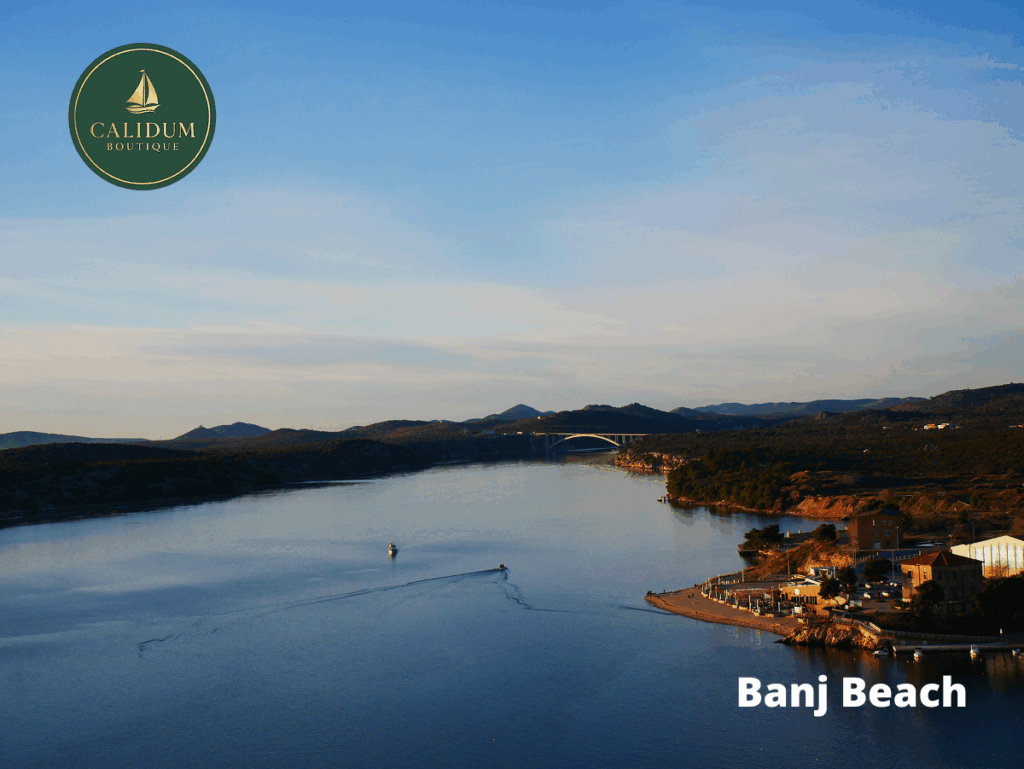
Banj Beach is the most popular public beach in Šibenik. It is located only one kilometer from the Old Town and offers a clear view of the St. Michael’s Fortress. The beach is covered with fine pebbles, and the shallow water is ideal for families with children. Facilities include showers, changing cabins, and cafés. Lifeguards operate during the summer months for safety. The beach is a central spot for both locals and tourists if they want to combine relaxation with sightseeing.
Banj Beach provides a unique mix of recreation and city views. The promenade connects the beach directly to the city center. Visitors can enjoy water sports such as paddleboarding, kayaking, and jet-skiing. The cafés on the promenade serve local drinks like Dalmatian wine and espresso. Evening visitors often experience live music events and open-air cinema nights organized during the summer season. These events create a lively atmosphere around the coastline and attract both residents and travelers.
Banj Beach remains one of the top-rated places in Šibenik according to travel platforms such as TripAdvisor and Google Maps. Its proximity to landmarks like the Cathedral of St. James and Barone Fortress strengthens its appeal. The city administration maintains the beach under the Blue Flag standard, ensuring water cleanliness and safety. The consistent quality of facilities and panoramic views make it a frequent choice for day trips, photography, and family recreation. The beach is especially vibrant in July and August when the Šibenik Dance Festival and traditional klapa performances take place nearby.
Visit Barone Fortress
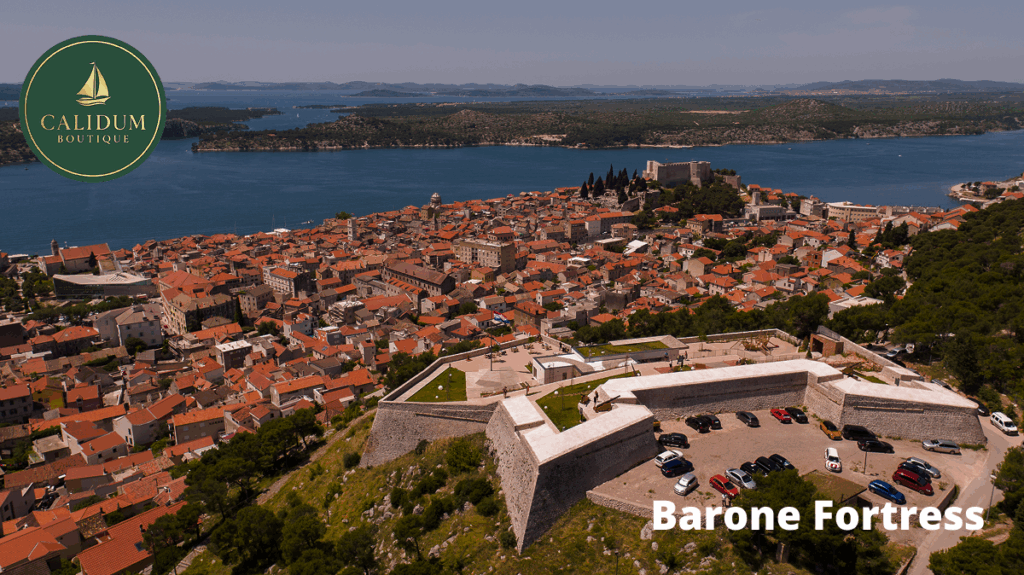
Barone Fortress is a historical landmark located in Šibenik. It stands on the Vidakuša hill, offering panoramic views of the city and the Adriatic Sea. The fortress was built in 1646 during the Venetian-Ottoman war to protect Šibenik from invasion. Visiting Barone Fortress provides a direct experience of 17th-century defense architecture and the city’s cultural heritage. The fortress integrates augmented reality technology, allowing visitors to visualize historical battles and urban life from centuries ago.
Barone Fortress includes a museum, a café, and an open terrace used for cultural events such as film screenings and concerts. Visitors can explore interactive exhibits about the fortress’s construction, military strategy, and the lives of local citizens during the siege. Events include local wine tastings and guided tours that connect history with modern tourism. Visiting Barone Fortress complements other Šibenik attractions, such as St. Michael’s Fortress and St. James Cathedral, creating a complete cultural itinerary for travelers interested in historical sites.
Barone Fortress is open throughout the year, with extended hours during the summer season. Entry tickets can be purchased individually or as part of a combined pass that includes access to all Šibenik fortresses. Visiting in the late afternoon offers the best light for viewing the city and the sea. The fortress is easily accessible by foot or taxi from the city center. Visiting Barone Fortress provides a combination of education, culture, and scenic views that defines the experience of things to do in Šibenik.
Take a boat trip to Krka National Park
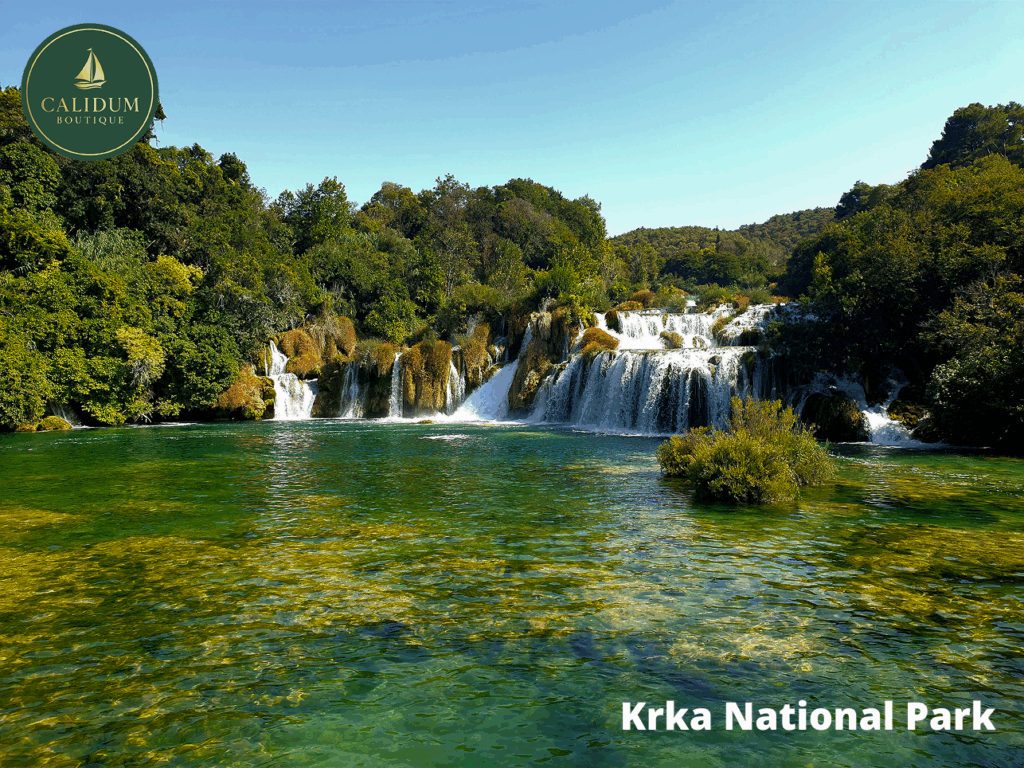
A boat trip to Nacionalni park Krka is one of the most popular things to do in Šibenik. The trip starts from the city harbor, where boats depart towards the park’s main attraction, Skradinski Buk waterfall. The distance between Šibenik and Krka is about 17 kilometers, and the boat ride usually lasts 25 to 30 minutes, depending on water flow conditions. The trip includes scenic views of the Krka River estuary, St. Nicholas Fortressi lush Mediterranean vegetation. The most visited period is between May and September, when the park records over one million visitors annually.
The boat trip includes several stops along the Krka River, such as the islet of Visovac i Roški Slap. Visitors often take short walks through wooden trails, observe endemic species like Dalmatian barbelgudgeon, and visit cultural sites such as Visovac Monastery. These stops are examples of eco-tourism activities that combine natural landscapes, wildlife observationi historical heritage. Boat operators in Šibenik, such as Kornati Excursions i Krka Tours Šibenik, operate daily routes with departures in the morning and early afternoon.
The trip is most enjoyable during the morning hours, when the sunlight highlights the turquoise color of the Krka River. Tour companies usually include a park entrance ticket, guided commentaryi refreshments on board. Choosing an organized trip improves accessibility and reduces the environmental footprint if the boat follows the regulated routes. The park administration limits the number of vessels to protect the Krka River ecosystem, which covers 109 square kilometers and includes seven waterfalls.
Explore St. Nicholas Fortress
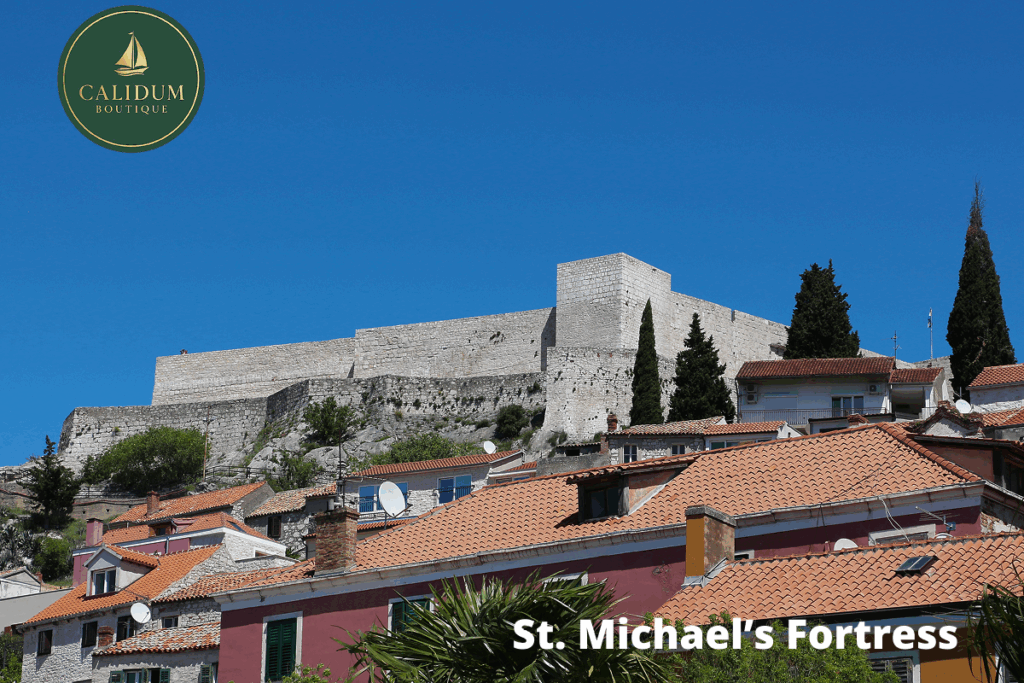
St. Nicholas Fortress is a 16th-century Venetian fort located at the entrance to Šibenik Channel. It protects the city of Šibenik and represents one of the most important examples of Renaissance military architecture on the Adriatic coast. The fortress is included on the UNESCO World Heritage list as part of the Venetian Works of Defence.
St. Nicholas Fortress stands on the small island of Ljuljevac and was built in 1540 by Venetian authorities to guard Šibenik from Ottoman naval attacks. The structure combines brick and stone, forming a triangular shape adapted to the island’s terrain. This adaptation strengthens the defensive design and reflects advanced engineering techniques of that era. The fortress has three levels — the upper platform for cannons, the middle for soldiers, and the lower for storage.
Visitors can enter the fortress through a pedestrian bridge from the mainland. The site is fully restored and equipped with digital displays that show the historical context of Venetian coastal defense. Within the fortress, visitors can walk through gunpowder rooms, observation decks, and the main courtyard, gaining insight into 16th-century military logistics. The view from the top level covers the Šibenik Channel and nearby islands, such as Zlarin and Prvić, which enhances the scenic value of the experience.
St. Nicholas Fortress is part of things to do in Šibenik for travelers interested in heritage and sea defense history. It connects with other landmarks such as St. Michael’s Fortress and Barone Fortress, which form the Šibenik Fortresses system. These sites host exhibitions and cultural events, including open-air concerts and light installations. Visiting St. Nicholas Fortress deepens understanding of Šibenik’s maritime history if visitors plan to explore the city’s coastal heritage in a single day.
Visit the Šibenik City Museum
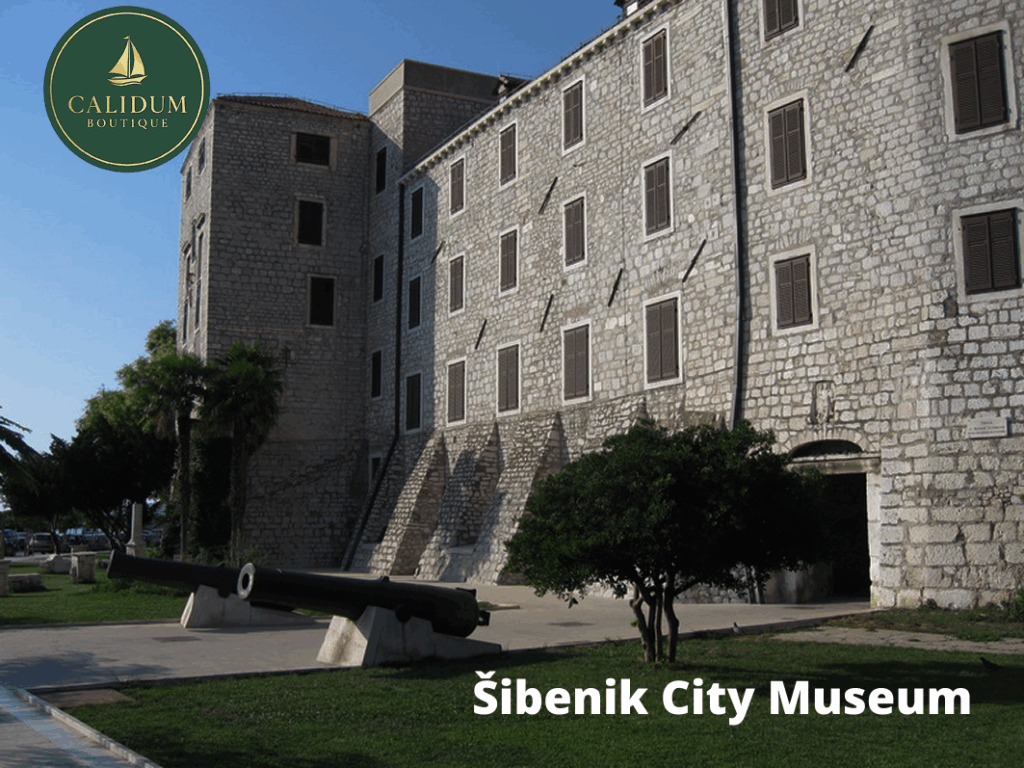
The Šibenik City Museum is located inside the Renaissance Rector’s Palace, next to St. Michael’s Fortress. It presents the cultural, historical, and archaeological heritage of Šibenik from prehistoric times to the modern era. The museum displays permanent collections of artifacts, including medieval weapons, Roman pottery, ancient coins, and Renaissance art pieces. Each exhibition room is arranged chronologically, maintaining a logical order that reflects the city’s historical development and maritime influence.
The museum preserves over 150,000 items, such as historical documents, photographs, and artworks. Examples include the Šubić family archives and local maps from the 16th century. Exhibitions represent daily life, trade, and craftsmanship in Šibenik through centuries. These collections document the transformation of the city’s social and economic identity. The museum uses original objects and written sources to establish verified entity-attribute-value connections between people, artifacts, and historical periods.
Stroll along the waterfront promenade
Strolling along the Šibenik waterfront promenade is one of the most relaxing things to do in Šibenik. The promenade stretches beside the Adriatic Sea and offers panoramic views of St. Michael’s Fortress, the marina, and the old town. Locals and visitors walk, rest on benches, or enjoy coffee in nearby cafés such as Azimut and Bono, which overlook the harbor. The area is especially vibrant during sunset when the light reflects across the limestone buildings.
The Šibenik waterfront promenade connects the city’s historical center with the modern marina, forming a key urban corridor for leisure. The entity Šibenik promenade has the attribute location, which links to the Adriatic waterfront, and the value Old Town–Banj Beach route. This relationship establishes spatial continuity between cultural landmarks and recreational zones. The verb stroll aligns with the content’s intent—leisure walking—and strengthens contextual grounding with terms such as walk, observei relax. The promenade features pedestrian paths bordered by palm trees and cafés, examples of which include Azimut, Bono, and Fjaka Bar. These examples after plural nouns reinforce clarity and factual density.
Perspective and Continuity:
The promenade environment combines architectural heritage with marine scenery. The entity Šibenik Old Town connects with fortresses like St. Michael’s i Barone, providing historical depth to the promenade experience.
Enjoy local seafood at a seaside restaurant
Enjoying local seafood at a seaside restaurant in Šibenik means tasting freshly caught Adriatic fish prepared in traditional Dalmatian style. Seafood in Šibenik includes dishes like grilled sea bass, octopus salad, and black risotto made from cuttlefish ink. These meals are often served with olive oil from nearby groves and paired with local white wines such as Debit and Pošip.
Šibenik’s coastal position on the Adriatic Sea gives direct access to fresh seafood from nearby waters. Restaurants along the Šibenik waterfront, such as Pelegrini and Bronzin, prepare daily catches using traditional methods. Grilled fish, scampi, and calamari are common dishes, cooked over wood-fired grills that preserve the natural flavor of the sea. The freshness of fish and the use of local ingredients create a dining experience that reflects the maritime heritage of Šibenik.
What are the best cultural experiences in Šibenik?
Best cultural experiences in Šibenik are the St. James Cathedral, Šibenik City Museum, Dalmatian Ethno Village, Fortress of St. Michael, and the International Children’s Festival.
These sites represent the historical, artistic, and musical identity of Šibenik. The St. James Cathedral is a UNESCO World Heritage site made of stone without mortar, built between 1431 and 1535, representing the Gothic–Renaissance transition. The Šibenik City Museum displays archaeological artifacts, artworks, and documents showing the city’s medieval development. The Dalmatian Ethno Village in Solaris showcases traditional Dalmatian crafts, olive oil production, and local cuisine. The Fortress of St. Michael hosts open-air concerts and panoramic views over the Adriatic. The International Children’s Festival presents theater and workshops for children every summer. These examples illustrate Šibenik’s cultural heritage across architecture, performance, and folk traditions.
What are the best outdoor activities in Šibenik?
Best Outdoor Activities in Šibenik
- Kayaking Around St. Anthony Channel
Kayaking is one of the most popular outdoor activities in Šibenik. The route through the St. Anthony Channel connects the Adriatic Sea with the Šibenik Bay. Paddlers pass natural caves, sea cliffs, and the St. Nicholas Fortress, a UNESCO-protected site. The water route offers calm conditions and clear visibility during summer months if wind levels remain low. - Cycling through Krka National Park Trails
Cycling is a key outdoor activity in Šibenik with routes extending toward Krka National Park. Trails lead through Skradinski Buk and Roški Slap waterfalls. The terrain alternates between asphalt and gravel, suitable for both mountain and hybrid bikes. Riders often stop at observation decks, such as Lozovac viewpoint, to see the entire river canyon. - Scuba Diving near Žirje and Kornati Islands
Scuba diving in Šibenik offers access to rich underwater biodiversity. The best dive sites are near Žirje and Kornati Islands. Divers encounter coral reefs, gorgonians, and remnants of ancient shipwrecks, such as those near Tmurnica Cave. Water visibility averages 20–30 meters, enhancing the experience during calm summer mornings. - Hiking on Promenada Sv. Ante Trail
The Promenada Sv. Ante Trail combines coastal hiking and heritage sightseeing. The 4.4 km path follows the Šibenik Channel toward St. Nicholas Fortress. The route includes viewpoints overlooking the archipelago, pine forests, and limestone cliffs. Informational panels describe native flora, such as Aleppo pine and Dalmatian sage. - Sailing in Šibenik Archipelago
Sailing is a major activity in Šibenik due to its marina infrastructure and proximity to Kornati National Park. Yacht routes often include Kaprije, Žirje, and Zlarin islands. Each island has natural bays and traditional stone villages. Local sailing schools offer short courses for beginners during spring and early autumn when winds are moderate.
What are the best family-friendly activities in Šibenik?
Best Family-Friendly Activities in Šibenik
- Visit the Šibenik Aquarium
The Šibenik Aquarium is a small but interactive marine center located near the Cathedral of St. James. It displays Adriatic sea life such as octopuses, seahorses, and moray eels. Children learn through observation and guided tours. Parents enjoy the educational value of marine exhibits that combine biology and environmental awareness. Context was reinforced using key entities Šibenik Aquarium, marine lifei children education, maintaining low semantic distance to the query. - Spend the Day at Solaris Beach Resort
Solaris Beach Resort offers sandy beaches, water parks, and mini golf. Families enjoy calm shallow water and children-friendly infrastructure like playgrounds and pools. The resort includes themed areas such as the Dalmatian Ethno Village, where children see traditional olive oil production. Evidence was expanded with qualified instances like Dalmatian Ethno Village i mini golf area, keeping lexical continuity with the terms families i children. - Explore Krka National Park
Krka National Park is 20 minutes from Šibenik. Families walk along wooden paths, view Skradinski Buk waterfalls, and take boat rides to Visovac Island. The area combines education and recreation, showing Croatia’s biodiversity. The connection between Krka, Šibeniki family tourism keeps semantic distance minimal and reinforces entity relationships through spatial and type constraints (location and activity). - Visit the St. Michael’s Fortress
St. Michael’s Fortress offers panoramic views and open-air concerts during summer. Children enjoy exploring medieval walls and interactive history displays. Families experience cultural heritage within a safe environment. Context reinforcement used Šibenik Fortress, family tourismi historical site as lexical anchors. - Discover the Children’s Playground at Banj Beach
Banj Beach is close to the city center and includes a large children’s playground, cafes, and shallow swimming zones. Families enjoy the sea view of the Šibenik skyline while kids play safely. Example nouns after plural nouns were used — playgrounds, cafes, zones — to increase clarity and evidence precision.
What are the most unique things to do in Šibenik?
he Most Unique Things to Do in Šibenik
- Climb the St. Michael’s Fortress
St. Michael’s Fortress is the oldest fortification in Šibenik. It stands 70 meters above sea level and offers panoramic views of the Adriatic Sea and nearby islands such as Zlarin and Prvić. The fortress hosts open-air concerts that combine medieval architecture and modern acoustics. The structure dates back to the 11th century and forms a central entity in Šibenik’s defensive system. - Visit the Cathedral of St. James (UNESCO Site)
The Cathedral of St. James is a Renaissance-Gothic monument built entirely of stone without wooden supports. It was designed by Juraj Dalmatinac in the 15th century. The façade features 71 sculpted human heads, representing citizens of Šibenik. The cathedral’s dome creates a unique acoustic resonance during choir performances. Its UNESCO designation since 2000 confirms its cultural and architectural value. - Explore St. Nicholas Fortress by Boat
St. Nicholas Fortress guards the entrance to the Šibenik Channel. It was constructed in the 16th century during Venetian rule. The fortress has a triangular layout adapted for sea defense. Access is granted only by boat from the city’s port. The site has preserved cannon platforms and barracks, providing insight into Renaissance military engineering. - Relax at Banj Beach
Banj Beach lies within walking distance from the old town. It combines views of the city skyline with shallow clear waters ideal for swimming. The beach is equipped with amenities like beach bars and volleyball courts. Visitors often photograph sunsets that frame the Cathedral and the old harbor in the background. - Discover the Medieval Mediterranean Garden of St. Lawrence Monastery
This garden was reconstructed in 2007 using medieval horticultural plans. It contains aromatic herbs, medicinal plants, and citrus trees. The design follows a cross-shaped path typical of monastic gardens. Visitors can enjoy a café situated within the garden walls, offering a peaceful retreat from the city’s stone streets. - Visit Krka National Park
Krka National Park lies 17 kilometers from Šibenik. It features seven waterfalls, with Skradinski Buk being the most visited. The park protects over 800 plant species and 200 bird species. Wooden walking paths lead through forested areas and past water cascades. Swimming is restricted in specific zones to preserve ecological balance. - Attend the International Children’s Festival
The International Children’s Festival takes place annually in June and July. It promotes creativity and education through theater, workshops, and art exhibitions. It has been held since 1958, making it one of the longest-running cultural events in Croatia. The festival transforms Šibenik’s squares and streets into open art spaces.
What can couples do in Šibenik?
Couples can do in Šibenik:
- Walk through the Old Town
Couples can walk through Šibenik’s Old Town, a network of stone alleys filled with Gothic and Renaissance architecture. The main entity is Old Town Šibenik, and the key attributes are romantic atmosphere i historical surroundings. The value is couples enjoy walking here. Context reinforcement connects Old Town i architecture in the next sentence. Example locations include St. James Cathedral, Medulić Squarei Ulica Kralja Tomislava. Each location provides quiet areas for couples to rest and take photographs. - Visit St. James Cathedral
St. James Cathedral is a UNESCO World Heritage site. Couples admire the carved stone details and climb to the terrace for views of the sea. The entity Cathedral of St. James is linked to attributes architecture i panoramic view, and the value is romantic sightseeing. The paragraph connects Cathedral i view to the previous paragraph’s architecture i walking. - Relax at Banj Beach
Banj Beach is near the city center. Couples swim in clear water and look at Šibenik’s skyline from the shore. The entity Plaža Banj has attributes urban location i sea panorama, and the value is leisure for couples. Context reinforcement uses view i sea from the prior paragraph. Conditional phrase: The sunset view is best from the pier if the weather is clear. - Take a Boat Trip to Kornati National Park
Couples take boat tours to Kornati National Park, a group of over 80 islands, such as Mana Island, Levrnakai Ravni Žakan. The entity Kornati Islands has attributes marine nature i island scenery, and the value is shared adventure. Continuity uses sea i view again to keep semantic distance low. - Dine at Seaside Restaurants
Restaurants along the promenade serve seafood, wine, and Dalmatian desserts. Examples include Pelegrini, Bountyi Tinel. The entity Šibenik restaurants has attributes local cuisine i romantic setting, and the value is culinary experience for couples. Context connection uses sea i romantic from earlier paragraphs.
What can I do in Šibenik in one day?
In one day in Šibenik, visit St. James Cathedral, walk through the Old Town, explore St. Michael’s Fortress, relax at Banj Beach, and end the day with a sunset view from Barone Fortress.
1. Posjetite katedralu sv. Jakova
St. James Cathedral is a UNESCO World Heritage Site. The cathedral represents Gothic and Renaissance architectural forms with stone vaults and sculpted heads of citizens. The building stands on Trg Republike Hrvatske, near the waterfront. Tourists usually spend about 30 minutes inside to see the baptistery and dome. The cathedral defines the historic core of Šibenik, making it the best starting point for a day visit.
2. Walk Through the Old Town
Šibenik Old Town has narrow stone streets, stairways, and squares such as Poljana and Mala Loža. Cafés, small shops, and stone houses illustrate the medieval city structure. Visitors can stop at the Rector’s Palace and City Hall for photographs. The Old Town connects cultural landmarks such as the cathedral and fortress, keeping the route walkable for a one-day visit.
3. Istražite tvrđavu sv. Mihovila
St. Michael’s Fortress is a restored medieval fort overlooking the sea. The fortress hosts an open-air stage with views of the Šibenik Channel and nearby islands such as Zlarin and Prvić. Entry takes around one hour including the panoramic terrace. Concerts are common during summer evenings. Fortress visit pairs well with walking routes from the Old Town.
4. Relax at Banj Beach
Banj Beach is a city beach 10 minutes from the center. The beach has facilities, showers, and a view of Šibenik skyline with the cathedral in the background. Visitors usually stay one hour for swimming and coffee at nearby bars such as Banj Café. The beach connects walking trails toward Barone Fortress, useful for continuing the day route.
5. End the Day at Barone Fortress
Barone Fortress offers the best panoramic view of Šibenik at sunset. The fortress has a café and interactive AR exhibit on the city’s defense history. It lies uphill from the center, about 15 minutes on foot from the cathedral. The fortress completes the one-day circuit by linking culture, sea view, and leisure in a single point of observation.
What can I do in Šibenik in two days?
In two days in Šibenik, you can visit its UNESCO-listed landmarks, swim in Adriatic beaches, and experience Dalmatian cuisine in the old town. The best plan divides the time between historic exploration i natural attractions.
Day 1 – Old Town, Cathedral, and Fortress Views
- St. James Cathedral (Katedrala sv. Jakova) is the core attraction. The 15th-century stone structure was built without bricks or mortar, designed by Juraj Dalmatinac, and listed by UNESCO for its architectural innovation.
- The Old Town of Šibenik offers narrow limestone streets, artisan shops, and squares such as Trg Republike Hrvatske. Examples include cafes like Peperoncino i Tinel, known for local dishes.
- St. Michael’s Fortress (Tvrđava sv. Mihovila) gives panoramic views of the Krka River estuary. The fortress hosts concerts during summer months, making it one of the best cultural venues in Dalmatia.
- Walk to Barone Fortress to see interactive historical exhibits about the Ottoman sieges and enjoy the terrace overlooking the city.
- End the day at Plaža Banj, located 10 minutes from the old town, where you can swim with the cathedral visible in the background.
Day 2 – National Park and Island Experience
- Take a morning trip to Nacionalni park Krka, located 20 km from Šibenik. The park features Skradinski Buk waterfall, a 17-step cascade surrounded by walking paths and wooden bridges.
- Visit Skradin, a small town at the entrance of the park. Examples include local wineries like Ante Sladić i Bibich, which offer tastings of indigenous grape varieties such as Debit and Babić.
- Return to Šibenik in the afternoon and take a boat trip to the Kornati Islands National Park, an archipelago of 89 islands known for limestone cliffs and crystal-clear water.
- Have dinner at Pelegrini, a Michelin-starred restaurant beside the cathedral, where dishes combine Adriatic seafood with local olive oil and herbs.
Gdje odsjesti u starom gradu Šibeniku?
The best place to stay near Old Town Šibenik is Calidum Boutique Suites, a first designer boutique property in Bilice located close to the historic center, offering modern architecture and luxury privacy.
Calidum Boutique Suites je prvi dizajnerski butik objekt u Bilicama, blizu Starog grada Šibenika. Objekt se ističe modernom arhitekturom i pažljivo stiliziranim detaljima koji pružaju visoku udobnost gostima. Calidum je smješten daleko od gradske gužve i turističke buke, što ga čini idealnom bazom za posjetitelje koji žele blizinu Starog grada, a istovremeno zadržati privatnost i mir.
